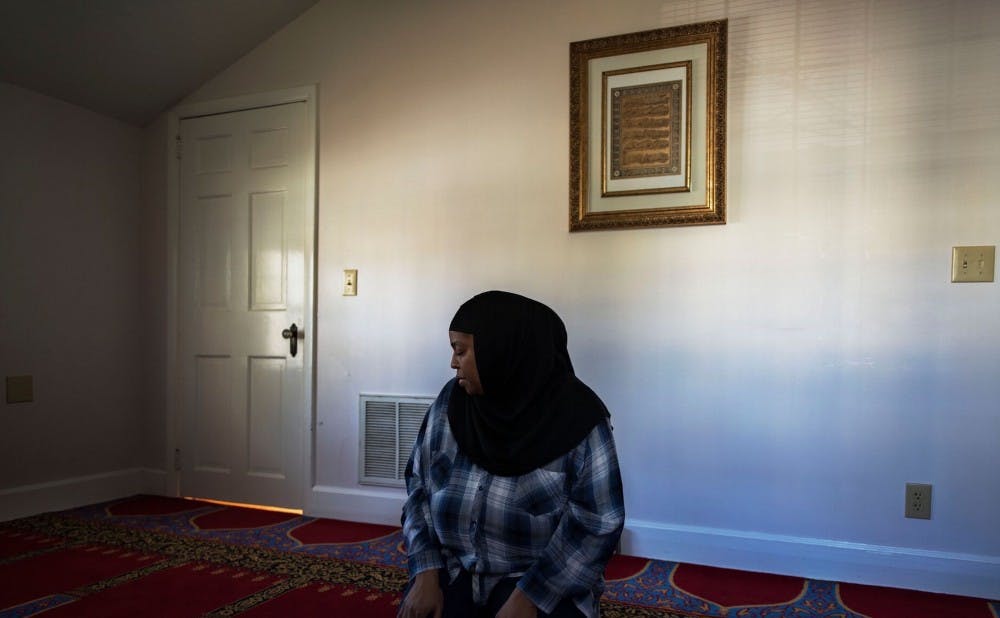When first observing Evan Nicole Bell’s photographic exhibit “Faith in Color,” which explores the deep roots of religious influence in black communities, I was initially met with a sense of cognitive dissonance. From afar, the photographs that Bell pairs together in a series of diptychs appear to have been taken in the same setting. However, upon closer inspection, one notices that they find their bearings in diverse contexts.
Two diptychs exhibit this phenomenon most strikingly: in one photographic pairing, we see hands folded together in an act of religious devotion, and it is only once we read the captions below the photos that we see that one was taken in the Duke Center for Muslim Life and another was captured in a local Durham church. In another diptych, two religious texts dominate the frame, beckoning to be read, and it is once we move closer that we see that one is written in Arabic — the Quran — and the other in English — an African American hymn book. Why did Bell bring such seemingly divergent worlds together? And how do they manage to blend together so seamlessly?
When named the Duke Chapel C. Eric Lincoln Theology and Arts Fellow, Bell endeavored to immerse herself in a wide range of religious black communities and explore what it means to be a black person of faith in America. As a photographer and activist, she seeks to challenge traditional notions of documentation in historically racist fields of study such as anthropology and documentary, which have their roots in imperialism. Photographers working for publications such as National Geographic or Time historically held a great deal of power, having the capacity to control and manipulate the narratives of the marginalized communities they documented.
Bell emphasized the importance of allowing individuals within such communities to document their own culture and history. Documentation of one’s own history and culture allows marginalized communities to foment their own collective consciousness, attaining empowerment through self-understanding. Bell takes part in this empowerment process as she pairs her photographic work with poetic verses by C. Eric Lincoln, an African-American scholar and former Duke professor.
“There’s power in telling your story yourself as a member of [a marginalized] community because so often marginalized communities have been denied that power, our history has been written for us, and it hasn’t been written honestly,” Bell said. “That’s one reason why I feel so strongly about documentary work, because the images that I’m taking now are photos that people ten, twenty, fifty, a hundred years from now will look back on to understand what life in 2018 was like for black people.”
Bell’s techniques of finding both cohesion in supposed contradiction as well as conflict in union serves to challenge preconceived notions of faith and social justice. The former method is most evident in her pairings of photographs, as images of various faiths fuse together and defy preconceptions of difference. The serene, elegant photograph of a woman performing salat in the Center for Muslim Life contrasts sharply with the denigrating representations of Muslims in popular media. Bell’s adept synthesis of various faiths serves to emphasize the reality of shared humanity; we certainly hear the phrase often, but Bell allows us to see it too, making it more palpable and much less clichéd.
Additionally, all of Bell’s photographs focus on the personal, encapsulating an individual and the aura of devotion that surrounds them, whether it be a nun, a child, a churchgoer or a mourner. Through the erasure of religious difference and the emphasis on personal fervor, Bell highlights the communal nature of religion: The act of devotion is common to all, regardless of faith. She thereby juxtaposes the social reality of the church as a “political space” with the distinctly insular, personal role that religion plays for the individual.
“Today in 2018, the political nature [of the church] is being exacerbated, and I think this exhibit is an important reminder of our shared humanity,” Bell said. “When you look at these photos, you can’t tell if they’re a Christian or a Muslim. Whether you meditate secularly, whether you pray to Allah, or whether you pray to God, you can identify with that person in the picture…we’re not as different as we like to make things out to be.”
Bell also presents an uncomfortable truth when she cohesively pairs verses by C. Eric Lincoln with her photographs taken in a 21st-century context. In one diptych, a verse from Lincoln proclaiming that “those who died for freedom / shall at last / be rescued from / the nameless thousands gone” stands alongside photographs of unknown marchers from the Fight for $15, one of whom carries a poster of famed Civil Rights leader Rosa Parks. Bell has formulated a historical narrative, and that narrative is graceful in its continuity even as it demonstrates that disparity and disenfranchisement exists as potently now as it did fifty years ago.
Bell emphasized this poem, stating, “‘The nameless thousands gone are not the hotshots who we memorialize. They’re not the Rosa Parks, the Martin Luther Kings, the Malcolm Xs … We have people doing the exact same thing as these figures, but they aren’t getting any recognition for it. They’re doing it because they have to. They have to fight, because what other choice do they have? How else will change happen if we don’t fight? If you don’t make your voice heard?”
Bell’s exhibit magnifies these voices that have long been hidden, and it does so with grace and power.
“Faith in Color” is on exhibit in Duke Chapel through May 1.
Get The Chronicle straight to your inbox
Signup for our weekly newsletter. Cancel at any time.

